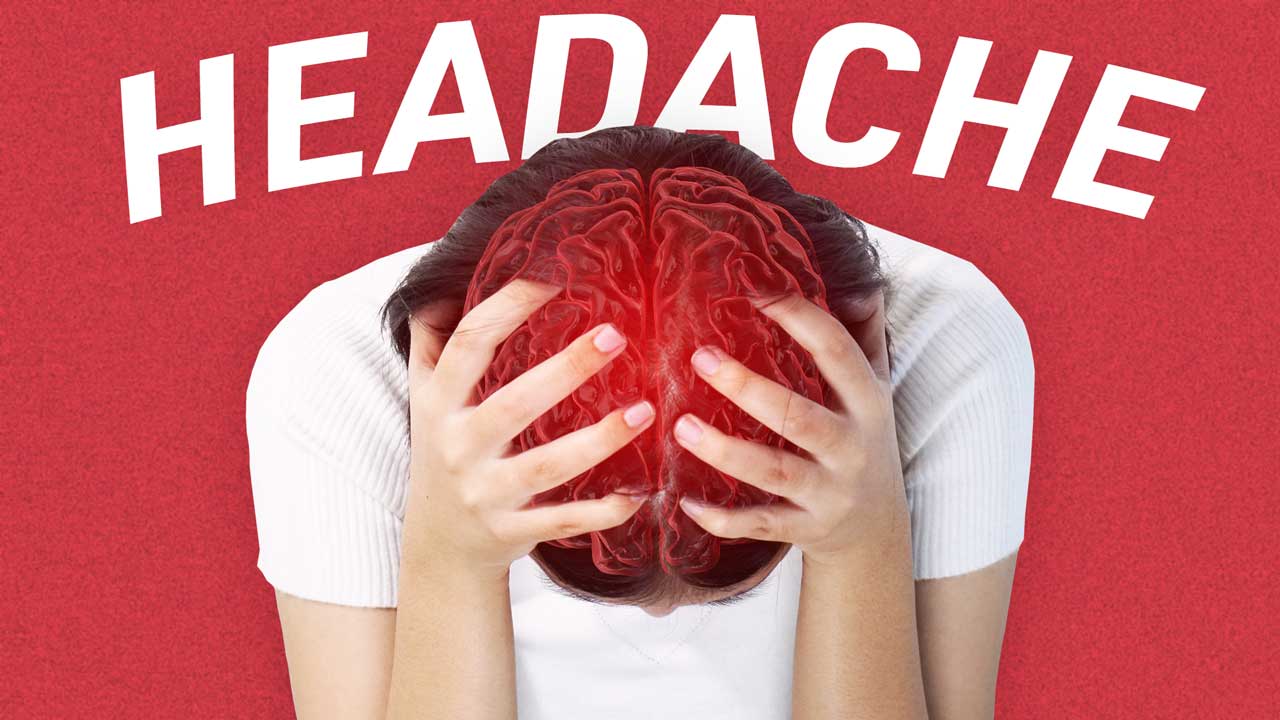Headaches are a varied and common symptom of many conditions. In fact, about 15% of Australians are estimated to be taking medication for a headache at any given time (Better Health Channel 2015).
What is a Headache?
The term ‘headache’ refers to any pain in the head area (Healthdirect 2023).
Headaches vary in severity, frequency and length. The pain may be sharp, throbbing or dull, with gradual or sudden onset, and may last from less than an hour to several days (Mayo Clinic 2020).
Headaches are common because there are so many different causes (Better Health Channel 2015). In fact, the International Classification of Headache Disorders (ICHD-3) recognises over 200 types of headaches (The International Headache Society 2021).
Headaches are divided into two categories:
- Primary headaches, which are not caused by an underlying illness or injury
- Secondary headaches, which are ‘secondary’ side effects of an underlying illness or injury.
(Mayo Clinic 2020)
A headache can be caused by anything that stimulates the pain receptors in the head or neck (Better Health Channel 2015).
Primary Headaches
Primary headaches can be related to chemical activity in the brain, nerves or blood vessels surrounding the skull, the muscles in the head and neck, or a combination of these. Some people may have a genetic predisposition to develop primary headaches (Mayo Clinic 2020). Some common types of primary headaches include:
- Cluster headache
- Migraine
- Tension headache.
(Mayo Clinic 2020)
Primary headaches may be caused by factors such as:
- Alcohol
- Certain foods (e.g. processed meats containing nitrates)
- Changes in sleep or lack of sleep
- Poor posture
- Skipping meals
- Stress.
(Mayo Clinic 2020)
Secondary Headaches
When an underlying condition or external cause activates the pain-sensitive nerves in the head, the individual may experience a secondary headache (Mayo Clinic 2020). Secondary headaches can include:
- Sinus headache
- Spinal headache (caused by low pressure or volume of cerebrospinal fluid)
- Thunderclap headache (a sudden, severe headache caused by migraine, orgasm or rapid increase of blood pressure)
- Medication headache (from overuse of pain medication)
- External compression headache (from compression-causing headwear).
(Mayo Clinic 2020; Migraine & Headache Australia 2021a)
There are many possible causes of secondary headaches, varying in severity. These include, but are not limited to:
- Acute sinusitis
- Blood clot
- Brain aneurysm
- Brain tumour
- Carbon monoxide poisoning
- Concussion
- Dehydration
- Ear infection
- Hangover
- Influenza
- Meningitis
- Stroke.
(Mayo Clinic 2020)
Please note this is not a complete list of possible causes.
Migraine

Migraine is a neurological disorder characterised by moderate to severe headaches accompanied by nausea. It affects about 4.9 million people in Australia (Migraine & Headache Australia 2021b).
Migraine headaches can last between four hours and three days. Some people might experience one or two per year, while others might have two or three per week. Women are commonly more affected than men, which is thought to be related to reduced levels of oestrogen during menstruation (Better Health Channel 2014).
Migraine Symptoms
According to diagnostic criteria from the International Headache Society, the symptoms of migraine are:
- Pain with at least two of the following characteristics:
- On one side of the head
- Moderate to severe in intensity
- Throbbing
- Worsened by movement, and
- At least one of the following associated symptoms:
- Nausea
- Vomiting
- Photophobia (sensitivity to light)
- Phonophobia (sensitivity to noise), and
- A headache that lasts between 4 and 72 hours.
(Migraine & Headache Australia 2021b)
Other migraine symptoms can include:
- Osmophobia (sensitivity to smell)
- Difficulty concentrating
- Feeling generally unwell
- Issues with articulation or co-ordination
- Diarrhoea
- Stiff neck or shoulders
- Tingling, pins and needles, numbness or limb weakness
- Speech difficulties
- Motor weakness
- Vertigo.
(Migraine & Headache Australia 2021)
Migraine with Aura
Also known as ‘classic migraine’, this type of migraine is characterised by recurrent migraine symptoms accompanied or preceded by visual and sensory disturbances known as aura (Mayo Clinic 2021; Jesani & Simerson 2019).
Aura symptoms most commonly begin within an hour before migraine symptoms, though sometimes they will occur without a migraine (Mayo Clinic 2021). Aura symptoms may include:
- Blind spots
- Zigzag lines across the field of vision
- Shimmering spots or stars
- Changes in vision or vision loss
- Flashes of light
- Numbness, generally on one side of the face or one hand that slowly spreads
- Speech or language difficulty
- Muscle weakness.
(Mayo Clinic 2021)
Diagnosing Headaches
Headaches can be caused by a combination of factors and in some cases, a serious underlying issue. Recurring headaches might require tests such as scans, eye tests and sinus X-rays to determine their cause (Better Health Channel 2015). The following factors may be considered when diagnosing a headache:
- Location of the pain
- Severity of the pain
- Duration of the pain
- Other symptoms
- How often the pain recurs
- Factors that worsen and improve the pain.
(Better Health Channel 2015)
Treating Headaches
Treatment depends on the cause of the headache. If the headache is recurring, it may be triggered by a lifestyle factor or particular behaviour. The following strategies may help to alleviate the pain:
- Relaxing in a quiet, dark space
- Sleeping
- Getting fresh air
- Staying hydrated
- Placing a cool or warm cloth on the forehead or back of the neck
- Massage
- Taking appropriate analgesic medicines.
(Healthdirect 2023)
Preventing Headaches

The following strategies may help to prevent headaches:
- Maintaining a healthy diet
- Staying hydrated
- Regular exercise
- Avoiding sitting or standing in one position for a long time (this can cause muscle tension)
- Reducing caffeine, alcohol and tobacco intake
- Stress-reduction strategies such as yoga, massage and meditation
- Maintaining a good posture
- Consulting an optometrist (if the headache is eye-related
- Avoiding overuse of headache medicines, which can cause ‘rebound’ headaches.
(Healthdirect 2023; Mayo Clinic 2024; Better Health Channel 2015)
When to Seek a Healthcare Professional
Most headaches are not serious but in rare cases can indicate a serious medical condition such as a stroke, meningitis or encephalitis (Mayo Clinic 2020). A person should seek medical attention if they are experiencing:
- An especially severe headache
- Difficulty seeing, speaking, walking, swallowing or understanding speech
- Confusion
- Fainting
- High fever (more than 39° C)
- Numbness, weakness or paralysis
- Stiff neck
- Persistent vomiting
- Fit or seizure
- Head injury
- Rash
- Possible poisoning.
(Mayo Clinic 2020; Healthy WA 2015; Nall & Veazey 2023)
Test Your Knowledge
Question 1 of 3
Which one of these headaches is considered a secondary headache?
Topics
References
- Better Health Channel 2014, Headache - Migraine, Victoria State Government, viewed 19 March 2025, https://www.betterhealth.vic.gov.au/health/conditionsandtreatments/headache-migraine
- Better Health Channel 2015, Headache, Victoria State Government, viewed 19 March 2025, https://www.betterhealth.vic.gov.au/health/conditionsandtreatments/headache
- Healthdirect 2023, Headaches, Australian Government, viewed 19 March 2025, https://www.healthdirect.gov.au/headaches
- Healthy WA 2015, Headache, Government of Western Australia, viewed 19 March 2025, https://healthywa.wa.gov.au/Articles/F_I/Headache
- The International Headache Society 2021, Classification - ICHD-3, The International Headache Society, viewed 19 March 2025, https://ichd-3.org/classification-outline/
- Jesani & Simerson 2019, ‘Pharmacologic Management of Acute Migraines in the Emergency Department’, Advanced Emergency Nursing Journal, vol. 41, no. 2, viewed 19 March 2025, https://www.nursingcenter.com/journalarticle?Article_ID=4982360&Journal_ID=646631&Issue_ID=4982045#P27
- Mayo Clinic 2020, Headache, Mayo Clinic, viewed 19 March 2025, https://www.mayoclinic.org/symptoms/headache/basics/definition/sym-20050800
- Mayo Clinic 2021, Migraine with Aura, Mayo Clinic, viewed 19 March 2025, https://www.mayoclinic.org/diseases-conditions/migraine-with-aura/symptoms-causes/syc-20352072
- Mayo Clinic 2024, Headaches: Reduce Stress to Prevent the Pain, Mayo Clinic, viewed 19 March 2025, https://www.mayoclinic.org/diseases-conditions/tension-headache/in-depth/headaches/art-20046707
- Migraine & Headache Australia 2021a, Headache Types, Migraine & Headache Australia, viewed 19 March 2025, https://headacheaustralia.org.au/types-of-headaches/
- Migraine & Headache Australia 2021b, Migraine, Migraine & Headache Australia, viewed 19 March 2025, https://headacheaustralia.org.au/migraine/
- Nall, R & Veazey, K 2023, ‘When is a Headache a Cause for Concern?’, Medical News Today, 28 November, viewed 19 March 2025, https://www.medicalnewstoday.com/articles/when-to-worry-about-a-headache
 New
New 
